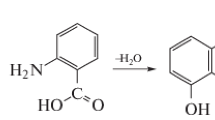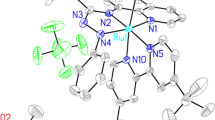Summary
Ruthenium(III) complexes of types [Ru(L)3], [Ru(L′)Cl(H2O)2], [Ru(L″)Cl2]n, [Ru(L‴)Cl(H2O)]n(LH =Schiff bases derived from anthranilic acid and benzaldehyde, acetophenone, vanillin, cinnamaldehyde orm-hydroxyacetophenone; L′H2=Schiff bases derived from anthranilic acid and salicylaldehyde oro-hydroxyacetophenone; L″H=Schiff bases derived fromp-aminobenzoic acid and benzaldehyde, acetophenone, vanillin, cinnamaldehyde orm-hydroxyacetophenone; L‴H2=Schiff bases derived fromp-aminobenzoic acid and salicylaldehyde oro-hydroxyacetophenone) have been synthesized and characterized on the basis of elemental analyses, conductance, magnetic moment and spectral (electronic, i.r. and1H n.m.r.) data. The wavelengths of the principal electronic absorption peaks have been accounted for quantitatively in terms of crystal field theory and various parameters have been evaluated. On the basis of the electronic spectra, an octahedral geometry has been established for all these complexes except [Ru(L″)Cl2]n. The complexes [Ru(L″)Cl2]n are pentacoordinate and a trigonal-bipyramidal environment, D3h, is suggested for the ruthenium(III) ion. The thermal behaviour of these complexes has also been studied by t.g., d.t.g and d.s.c techniques. Heats of reaction for the decomposition steps were calculated from the d.s.c. curves. The antifungal and antiviral activities of the complexes with Schiff bases derived from anthranilic acid were also investigated.
Similar content being viewed by others
References
R. C. Holm, G. W. Everett Jr. and A. Chakravorty,Prog. Inorg. Chem.,7, 83 (1966).
L. Sacconi,J. Am. Chem. Soc.,74, 4503 (1952);idem L. Sacconi,ibid. J. Am. Chem. Soc.,76, 3400 (1954);Coord. Chem. Rev.,1, 126 (1966).
S. Yamada,Coord. Chem. Rev.,1, 415 (1966).
R. H. Holm and M. J. O'Connor,Prog. Inorg. Chem.,14, 241 (1971).
N. S. Biradar, V. L. Roddabasanagoudar and T. M. Aminabhavi,Polyhedron,3, 575 (1984).
F. L. Bowder, R. P. Carpenter, R. V. Parrish and R. D. Pollock,Inorg. Chim. Acta,23, 35 (1977).
G. C. Percy,J. Inorg. Nucl. Chem.,37, 2071 (1975).
J. B. Hodgson and G. C. Percy,Spectrochim. Acta,32, 1291 (1976).
R. S. Nyholm and G. J. Sutton,J. Chem. Soc.,A, 567 (1958).
R. S. Nyholm,Proc. Roy Soc., 273 (1961).
M. Kotani,J. Phys. Soc. Jpn.,4, 293 (1949).
B. N. Figgis,Trans. Faraday Soc.,57, 198 (1961).
H. B. Gray and C. J. Ballhausen,J. Am. Chem. Soc.,85, 260 (1963).
M. C. Jain and P. C. Jain,J. Inorg. Nucl. Chem.,39, 2183 (1977).
R. W. Olliff and A. L. Odell,J. Chem. Soc., 2467 (1964).
Y. Tanabe and S. Sugano,J. Phys. Soc. Jpn.,9, 766 (1954).
A. B. P. Lever,Inorganic Electronic Spectroscopy, Elsevier, Amsterdam, 1968.
M. B. Gajendragad and U. Agarwala,J. Inorg. Nucl. Chem.,37, 2429 (1975).
J. S. Dwivedi and U. C. Agarwala,Indian J. Chem. 10, 657 (1972).
D. S. McClure,Solid State Phys.,9, 399 (1959).
S. E. Livingstone, J. H. Mayfield and P. S. Moore,Aust. J. Chem.,28, 2531 (1975).
B. N. Figgis,Introduction to Ligand Fields, Wiley Eastern, New Delhi, 1976.
C. K. Jorgensen,Hely. Chim. Acta, Faac. Extraord. Alfred Werner, 131 (1967).
C. Preti and G. Tosi,Transition Met. Chem.,3, 17 (1978).
K. Nakamoto,Infrared Spectra of Inorganic and Coordination Compounds, Wiley Interscience, New York 1970.
V. S. Sharma, H. S. Mathur and A. B. Biswas,Indian J. Chem.,2, 257 (1964).
C. Oldham,Prog. Inorg. Chem.,10, 223 (1968).
O. P. Pandey, S. K. Sengupta and S. C. Tripathi,Acta Chim. Hung.,116, 29 (1984).
G. K. Parashar and A. K. Rai,Synth, React. Inorg. Met.-Org. Chem.,8, 427 (1978).
N. F. Curtis,J. Chem. Soc., 1579 (1968).
A. B. P. Lever and D. Ogoen,J. Chem. Soc., 2041 (1967).
K. K. Deshmukh, A. M. Hundekar and D. N. Sen,J. Indian Chem. Soc.,LVII, 1147 (1980).
A. W. Coats and J. P. Redfern,Nature,68, 201 (1964).
J. G. Horsfall,Bot. Rev.,11, 357 (1945).
Author information
Authors and Affiliations
Rights and permissions
About this article
Cite this article
Sharma, V.K., Pandey, O.P. & Sengupta, S.K. Synthesis and physico-chemical and biological studies on ruthenium (III) complexes with Schiff bases derived from aminocarboxylic acids. Transition Met Chem 12, 509–515 (1987). https://doi.org/10.1007/BF01023837
Received:
Revised:
Issue Date:
DOI: https://doi.org/10.1007/BF01023837




